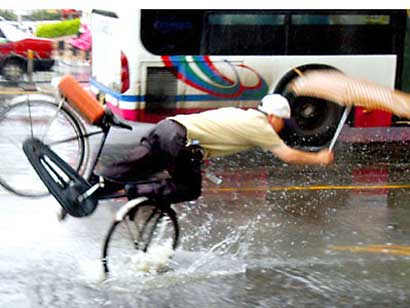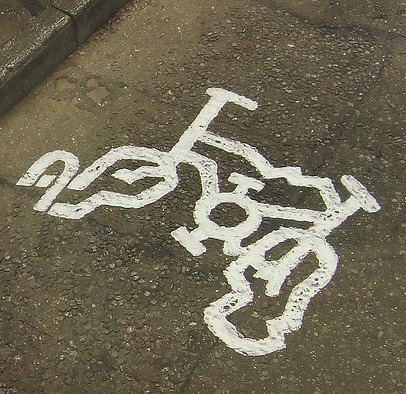Should helmet use be mandatory? I often see the debate online.
But the fact is, helmet use is already criminalized in almost every country on the face of the Earth, not by law but by the media. How often do we see news reports of cyclist deaths which state, in condemning tones: "The cyclist was not wearing a helmet"? Such articles seem to suggest that death or serious injury are appropriate penalties for such a 'crime'.
Since this is the case, any cyclist who refuses to wear a helmet should be aware that, no matter how innocent, competent and law-abiding he is on a bicycle, if he gets injured or killed in a collision on the road, he will be deemed guilty in the court of public opinion. It doesn't matter whether the driver who hit him was drunk, texting, talking on his cellphone, high on drugs, etc.: cyclists who don't wear helmets deserve death.
Sadly, that's the main reason I always wear a helmet. It has little to do with safety, and everything to do with PR. If I ever get killed on my bike, I do not want the newspapers to suggest that the death sentence was appropriate.
So I advise every cyclist to wear a helmet. Make sure it's comfortable, make sure it's cheap. Safety comes a distant third, because let's face it - the chances of sustaining a life-threatening head injury when you take your bike out for a ride are a couple of million to one against, and if you do happen to be in an accident, the jury is still out on whether a helmet even does much to help. It probably does, but it would for a car driver too, and how many of them wear helmets? Car accidents are more likely than cyclist accidents to involve head injuries, but how often do we see news reports of motorist deaths that say "The driver was not wearing a helmet"? Never.
So wear a helmet. In an accident it will undoubtedly save your reputation even though it might not save your life.
My sole mode of personal transportation is my bicycle. I've never driven a car and I'm quite proud of it.
This blog is my place to rant and rave about cycling issues as I see them.
This is not a place for critics of integrated cycling - that conversation is over - segregation has no future - studies show it is not a safe or useful strategy, nor is it a healthy philosophy.

Wednesday, 28 December 2011
Thursday, 22 December 2011
Cyclist Vulnerability
While looking for links for my first blog, I spotted this Treehugger article which referenced a now deleted newspaper article in which a driver was saying that the road is too dangerous for cyclists because cyclists are too vulnerable.
The thing is, this attitude, which is common among drivers, is based on a number of misconceptions.
Firstly, it assumes that pretty much all drivers are incompetent. Are they? I don't think so. Experience tells me that most drivers drive very carefully indeed. Sure, they break laws - they speed, they run stop signs. But they don't do these things particularly unsafely, unless they are impaired.
Secondly, it assumes that cyclists are incapable of being aware, incapable of seeing a situation, of anticipating problems and incapable of taking steps to avoid danger. Clearly this is not the case.
Thirdly, it assumes that cyclists always have an off-road option. In practice, this is hardly ever the case. In many places, cycling on the sidewalk is illegal and bike lanes and bike paths are fairly rare even in most cities.
Finally, it assumes that cycling on the road is more dangerous than cycling off it. Again, this is not the case. A study done in Denmark in 2007 concluded: "The safety effects of bicycle tracks in urban areas are an increase of about 10 percent in both crashes and injuries. The safety effects of bicycle lanes in urban areas are an increase of 5 percent in crashes and 15 percent in injuries. Bicyclists’ safety has worsened on roads where bicycle facilities have been implemented."
Further, statistics suggest that, over a short commute, cycling is actually safer than car travel. We appear very vulnerable, but in practice we are not as vulnerable as many folks seem to think. In 40 years and over 20,000 miles of cycling on the road in 15 different countries, I have never once been knocked off my bike. Sure, that's anecdotal, but Ken Kifer's review of statistics from the US Department of Transportation's 'The Environmental Benefits of Cycling and Walking' study and from 'Traffic Safety Facts 1997' suggests that the lifetime risk of a cyclist being killed while cycling is 1 in 142, while a car driver's risk is 1/83. So a cyclist's risk of being killed on any particular day is about 1 in 3,000,000. That's pretty darned low.
There's a lot of fear and a lot of fearmongering around this issue. The fact is, even though there is some incompetence out there on the roads, a cyclist's safety is almost always ensured by reasonably safe roads and every road user's unwillingness to be involved in an accident.
I began to suspect a long time ago that a lot of drivers' belief that cyclists belong off the road comes out of their own lack of confidence in their own abilities. They are frightened of doing something wrong and hitting us, so they create a fantasy of the vulnerable cyclist and the extreme danger of cycling in an effort to convince us to get off the road so that they don't have to worry so much about their fear that they're poor drivers.
Fear Kills Cyclists
Hi folks, welcome to the blog. I guess the first article is a bit of a downer to start off a blog, but what the hey.
Over the past few days, I've been reading a lot about cyclists dying on the road and about attempts to make cycling safer by implementing bike lanes and cycle paths. I've also been reading a lot of studies into the safety (or lack thereof) of such infrastructure.
Today I read about Deep Lee, a cyclist who was killed on 3 October 2011 at the junction of York Way and Gray’s Inn Road in the King's Cross area of London, England. Friends of Ms. Lee and cycling advocates have responded to her death by calling on the government to make the intersection where she died safer. Some of them are calling for a bike lane to be installed at the junction and on the roads leading from it.
The problem is, a cycle lane is not going to improve cycling safety. Studies show it's likely to make this road less safe. Bike lanes make cyclists feel safer, but the latest studies from Canada, the UK, the US, Copenhagen, Western Denmark and Belgium all note that such infrastructure increases the likelihood of collisions at intersections, making roads that feature bike lanes and so-called 'protected' bike tracks more dangerous than roads that don't.
The thing is, what killed Deep Lee (and what kills many cyclists) most likely had nothing to do with the road and everything to do with the fact that cyclists are encouraged to fear the road and stay out of the way of motorists. This culture of fear probably kills more cyclists than drunk drivers or anything else. From what can be gathered from the small amount of information available, Ms. Lee was riding in the gutter next to (or immediately in front of) the truck that killed her. If she had taken her place in the middle of the lane as a motorcyclist or any other vehicle driver would have done, the truck driver would have been more easily able to see her and she might be alive today.
The problem, in both the US and the UK, is that we have a culture that marginalizes cycling, encourages fearmongering and turns a blind eye to bullying on the road so that cyclists find it almost impossible to assert their right to the road or to ride safely. They are shunted off to the side of the road, and any who are brave enough to assert their right to the lane are honked at and treated to dangerously close passes, angry yells and obscenities by a tiny minority of drivers who think they have an innate right to travel at the speed limit, and that cyclists who 'get in their way' deserve to be scared or even 'nudged' off the road. Police are often part of the problem. Many cyclists prefer to avoid the hassle and stay out of motorists' way, even when they are warned that riding in the gutter and on poorly-planned cycling infrastructure places them at increased risk.
Cyclist deaths will not be meaningfully reduced until cyclists, one by one, decide to take back their rights and stand up to the bullies and the fearmongers by cycling legally and confidently integrated with traffic. No amount of cyclist infrastructure or transportation engineering can accomplish this. It can only be accomplished by cyclists deciding they've had enough.
Subscribe to:
Posts (Atom)


